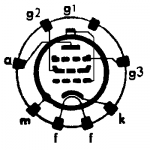
SP13
|
|
|||||||||||||||||||||||||||||||||||||
|
Entradas: 2636 Réplicas: 0
Repairing an Edge connect tube (valve) base
|
|
|
Michael Watterson
12.Nov.12 |
1
Maybe this has happened to one of your rare valves? Even if you are careful and only pull by the base. Perhaps the Radio comes with a tube like this? Originally the wires were long and they could be easily inserted into the base and then soldered and cropped. The solution is to clean out the old cement in the base and insert suitable tinned copper wire (I used some resistors, leaving the body on at the outside of base as I have some 1000s of one or two values I got free). The existing soldered connections need cleaned. I used a hand solder sucker (Braid is better for PCBs, but the rough hand operated plunger sucker is good for tags etc). I used fresh tin/lead 60/40 multicore fluxed solder to do a final clean. The ends of the tube (valve) wires need well cleaned and tinned as do the the tops of the inserted wires. How to decide on which connections go where? Start with the filament / heater as it has more resistance than a short and isn't open circuit (hopefully). But what of the other wires? Well the heater is at the center surounded by cathode (if indirect) and Anode (Plate) will be an outer connection with the grids inbetween.
The wires also have to match the base wiring diagram without crossing over.
The Ohm meter verifies the heater. The Cathode is beside the heater connections on the base so must be the sleeved wire on the right. The possibly ambiguous connections are only g2 (screen grid) & Anode. To 100% verify the Anode and Screen grid are correct, connect both to HT and more current can be achieved on Anode than on G2. If we have the orientation back to front there will be no current as we will have connected Cathode to HT and g2 to 0V. .
The wires (still on resistors!) inserted from below on base terminals reach just above the rim of the base allowing the tube wires to be easily soldered. Give each a little tug to make sure good joint. Then pulling out the resistors from base and pushing down the valve refit. I used two rolls of tape as a support for the top of the valve and pressed down on base while resoldering. Use 60/40 multicore flux solder, "lead free" solder is only suitable for modern lead free components on a modern cleaned PCB .
Then the tube is tested with suitable voltages. I used 12V heater (rated 13V) and 32V HT from my bench PSU. For the SP13 at low HT I connected top cap (g1) to 0V = cathode, g2 to cathode and g3 alternately to 0V or 32V. The g3 current at 32V was very low. The Ia at 32V HT varied from 0.6mA to 0.1mA switching the g3 from 32V to 0V
If the readings don't make sense, then maybe a Grid and Anode have got mixed up, the solder can be sucked out and try again. If the Cathode isn't connected or not at 0V, then likely there is no current and you can't easily get the filament/heater connections wrong. Finally use proper tube base cement or epoxy resin to cement glass to base (not Superglue). The connection of wire to metallisation can be repaired with PCB repair silver paint, RFI screening Nickle spray or foil/braid held tight with elastic band
|
Fin de las contribuciones al foro de válvula
| Cumplimiento de datos | Más información |









